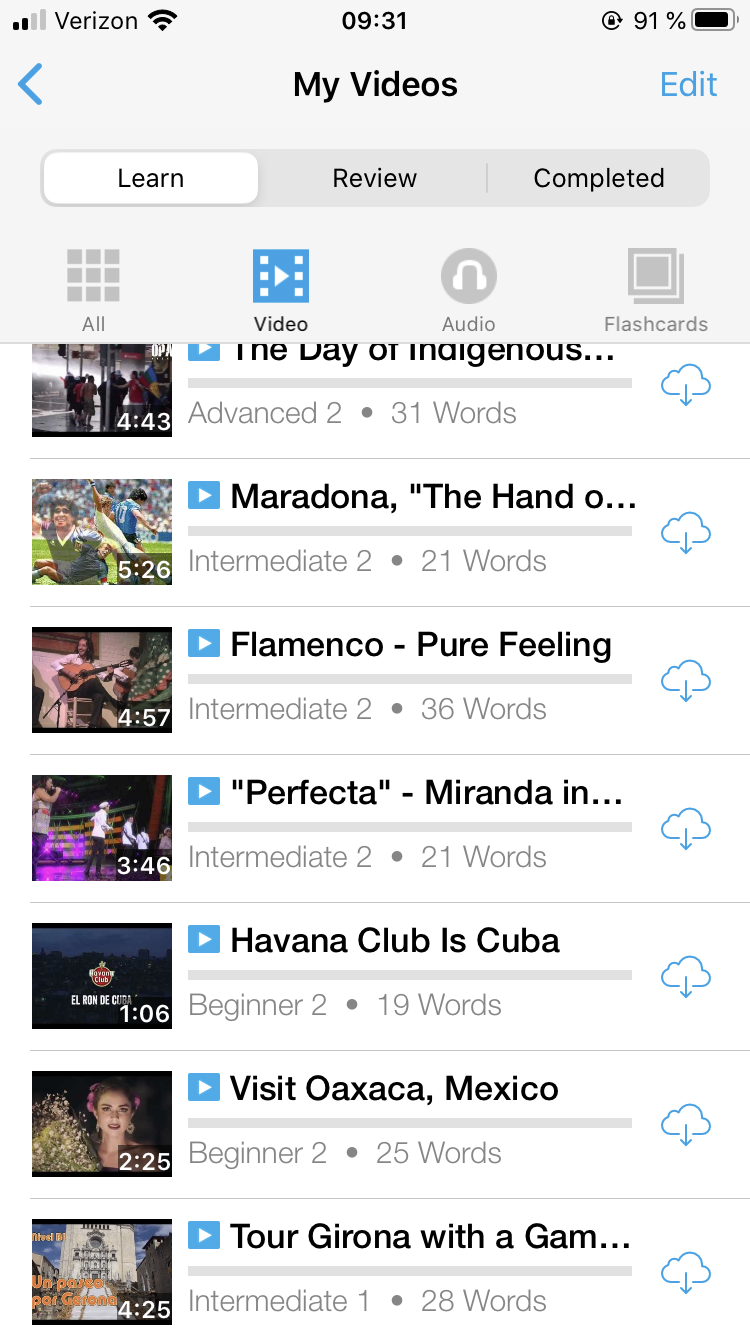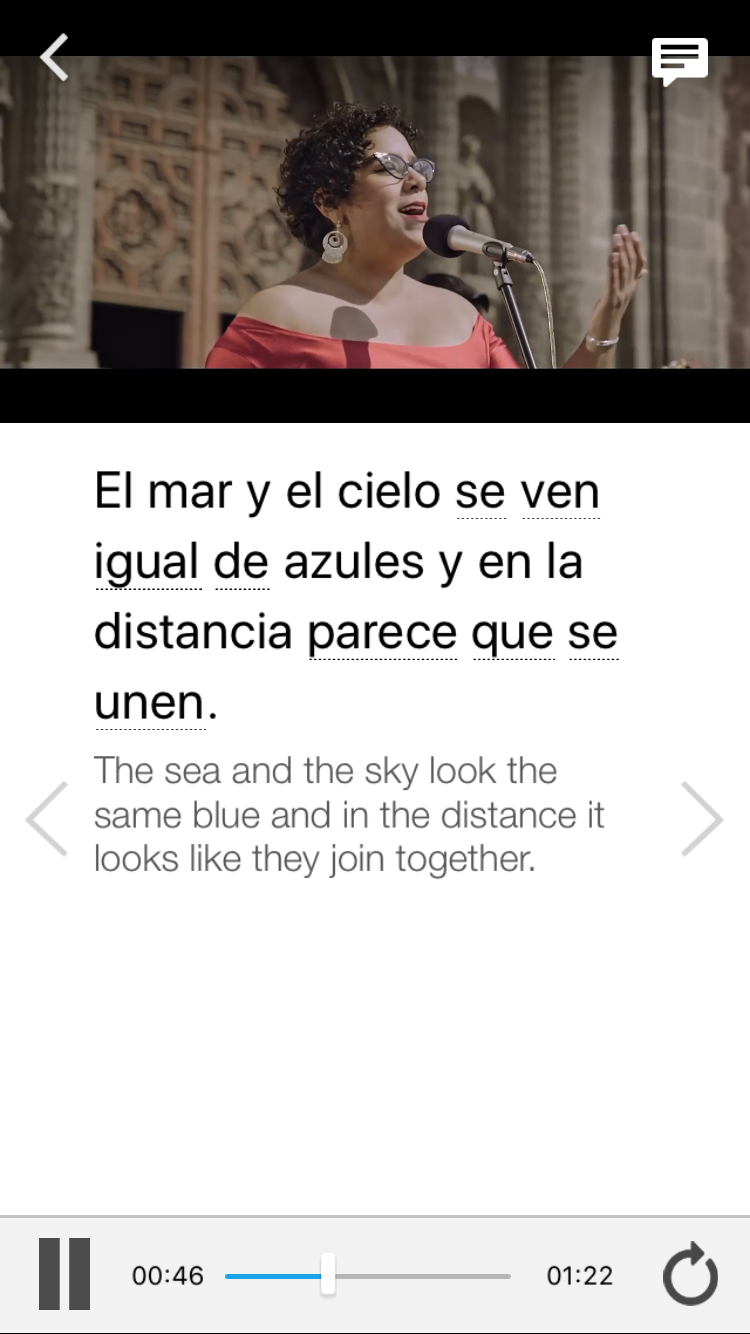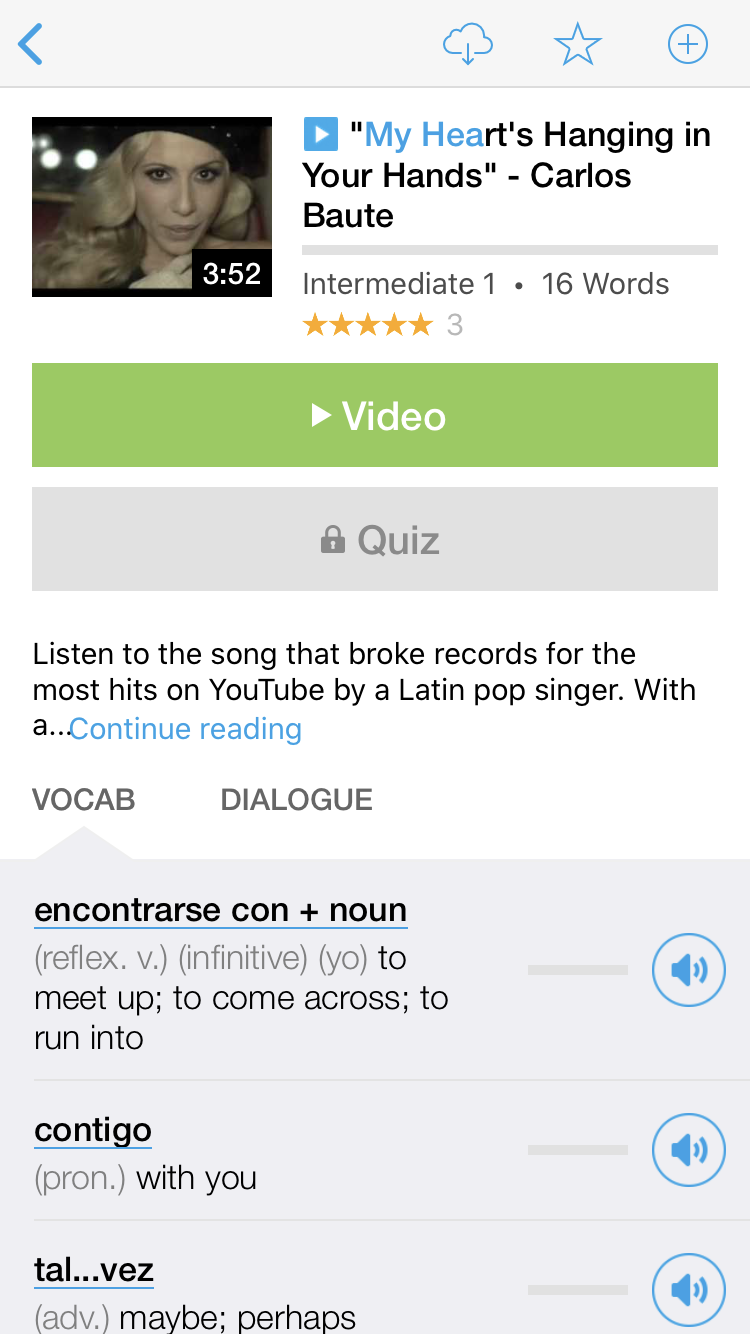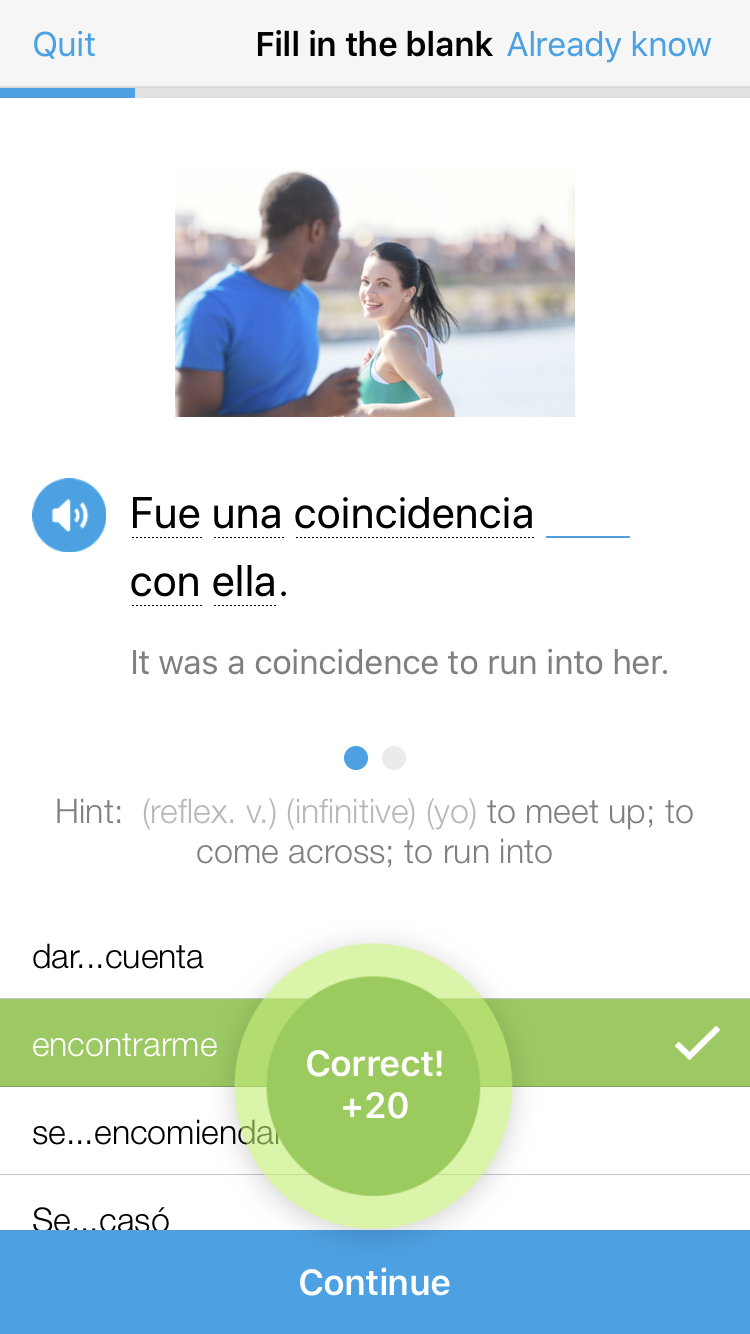
Spanish music is an international phenomenon. You’ve probably heard a few hit Spanish tunes in your day, or perhaps you’re a full-blown reggaetón
addict.
And let us tell you a secret, there’s a whole world of seriously cool Spanish singers out there doing their thing. And many of these Spanish songs have deep meaning, so it’s not only informative to listen to them, it’s inspiring.
But best thing about listening to these songs is that you get to learn Spanish while you dance and sing along. I can’t think of anything better.
Read on for 20 poppin’ songs by 20 great Spanish-speaking artists from around the world.
Contents
Download:
This blog post is available as a convenient and portable PDF that you
can take anywhere.
Click here to get a copy. (Download)
1. “Me Gustas Tú” by Manu Chao
Full lyrics: “Me Gustas Tú“
Level: Beginner
Lyrical excerpt:
My gusta la canela, me gustas tú
— I like cinnamon, I like you
Mu gusta el fuego, me gustas tú
— I like fire, I like you
My gusta menear, me gustas tú
— I like swaying, I like you.
Me gusta la Coruña, me gustas tú
— I like La Coruña (a city in Northern Spain), I like you
Me gusta Malasaña, me gustas tú
— I like Malasaña (a neighborhood in Madrid), I like you
Me gusta la castaña, me gustas tú
— I like the walnut, I like you
Me gusta Guatemala, me gustas tú
— I like Guatemala, I like you
Manu Chao’s happy-go-lucky song about all the things he likes in life is perfect for beginners. It’s also a really easy one to sing along to.
The structure of the song is simple, with the verses stating all the things Manu Chao likes. The chorus is a mix of French and Spanish (we’ll ignore the French for the purposes of this post, but if you’re learning French too then it’s a double whammy language lesson song).
This song is a good way to drill into your head the grammar of the verb gustar. If what you’re talking about is singular, the verb gustar
is singular (e.g. me gusta el mar
— I like the sea). If you’re talking about something plural (e.g. aviones) then gustar is plural ( me gustan los aviones
— I like planes).
2. “Vivir Mi Vida” by Marc Anthony
Full lyrics: “Vivir mi vida“
Level: Beginner
Lyrical excerpt:
Voy a reír, voy a bailar
— I’m going to laugh, I’m going to dance
Vivir mi vida lalalalá
— Live my life la la la
Voy a reír, voy a gozar
— I’m going to laugh, I’m going to enjoy myself
Vivir mi vida lalalalá
— Love my life, la la la
American Marc Anthony is absolutely huge in Latin America, and this song was a massive hit in 2013. It’s another uplifting song perfect for singing along at the top of your voice once you’ve mastered the words.
The vocabulary in the song is simple but useful. There are already a couple of words that are worth picking out and noting down, such as heridas
(wounds or injuries) and gotas
(drops, in this case he’s talking about rain).
The grammar is also fairly straightforward, so this is a good one to practice the present tense.
Also, as we can see with the chorus we’ve just translated, Anthony uses the “ir + a + infinitive” structure several times in the chorus ( Voy a bailar
, for example).
If you ever get stuck trying to think of how to form this tense, next time you can just think of Mark Anthony and his plans for laughing, dancing and generally having a good time and living life. For more on this future form as well as other ways to talk about the future, see this post.
3. “Bailando” by Enrique Iglesias
Full lyrics: “Bailando“
Level: Beginner
Lyrical excerpt:
Yo quiero estar contigo
— I want to be with you
Vivir contigo, bailar contigo
— Live with you, dance with you
Tener contigo una noche loca (una noche loca)
— Have a crazy night with you, a crazy night
Ay, besar tu boca (y besar tu boca)
— Oh, kiss your mouth (kiss your mouth)
Oh, Enrique. You hoped he was going to come up, didn’t you?
If you didn’t and you’re upset about the lack of female artists on this list, we’ll kindly direct you to our post on learning Spanish with Shakira. Yes, the Colombian goddess gets her own post all to herself.
Remember that this song is different from “Bailamos” even though they’re both about dancing. This one is far less smoochy and more upbeat, and the video involves a lot of people bailando
(dancing) in the streets. Although it all maybe got a bit much for Enrique as he seems to have taken refuge in a tunnel.
Useful vocabulary is, as we would expect from Enrique, all related to the corazón
(heart). He talks about his heart beating slowly ( me palpita lento
). Palpitar
is the verb “to beat” (as in heartbeat, not beating someone at Scrabble). He also croons about bodies going up ( subiendo
) and down ( bajando
), but we know he’s still talking about the dancing as he keeps repeating the word bailando, just in case anyone misinterprets him.
Again, the song is mostly in the present tense, so it’s nice and simple.
4. “La Tortura” by Shakira + Alejandro Sanz
Full lyrics: “La Tortura”
Level: Intermediate/advanced
Lyrical excerpt:
No pido que todos los días sean de sol
— I don’t ask that every day be sunny
No pido que todos los viernes sean de fiesta
— I don’t ask that every Friday be a party
Tampoco te pido que vuelvas rogando perdón
— Nor do I ask that you’ll come back begging for forgiveness
Si lloras con los ojos secos y hablando de ella
— If you cry with dry eyes and talking about her
The song’s lyrics are a goldmine for picking up everyday expressions and poetic vibes, making it a fun way to boost your vocabulary and get a feel for the culture.
5. “Where She Goes” by Bad Bunny
Full lyrics: “Where She Goes”
Level: Beginner/intermediate
Lyrical excerpt:
No me gusta perder
— I don’t like to lose
Dime qué vamo’ a hacer
— Tell me what we’re going to do
Me paso mirando el cel
— I pass time looking at my cell phone
Wow, no puede ser
— Wow, it can’t be
The lyrics are filled with contemporary colloquialisms and urban language, so you’ll be up to date on how young, cool Spanish speakers actually use hte language.
While listening, see what insights into Puerto Rican and Latin American culture you can garner. Are there words you haven’t heard before? How about “wow”? Did you know Spanish speakers used that English term?
6. “Shakira: BZRP Music Sessions, Vol. 53” by Bizarrap & Shakira
Full lyrics: “Shakira: BZRP Music Sessions, Vol. 53”
Level: Intermediate/advanced
Lyrical excerpt:
Perdón, ya cogí otro avión
— Sorry, I already took another plane.
Aquí no vuelvo, no quiero otra decepción
— I’m not coming back here, I don’t want another lie.
Tanto que te la das de campeón
— So much so that you look like a champion
Y cuando te necesitaba diste tu peor versión
— And when I needed you, you have your worst version
This song includes some great things to say to break up with someone.
Notice that English borrowing of the word “wow,” which also appeared in the Bad Bunny song before this.
Another interesting thing to keep in mind when you’re listening to this song is the ease with which Spanish speakers rhyme words. With most words ending in similar ways (-a, -o or –ion), it’s a pretty easy thing to do in Spanish lyrics.
7. “Superdeli” by Caloncho
Full lyrics: “Superdeli”
Level: Intermediate
Lyrical excerpt:
No es tan imposible la utopía
— Utopia is not so impossible
Tú con tus ideas, yo las mías
— You with your ideas, me with mine
Coincidir en esta travesía
— Match on this journey
Por si no te encuentro en otra vida
— In case I don’t find ou on another life
Using super clear Spanish word choices and mostly the present tense, this song is great for hearing words that you already know used in context and in a modern way.
Focus on the use of the infinitive verb at the starts of many lines, and also look at the easy rhyming style that Spanish gives songwriters.
8. “Primera Cita” by Carin Leon
Full lyrics: “Primera cita”
Level: Intermediate/advanced
Lyrical excerpt:
Te vi, me viste, al principio fue una broma
— I saw you, you say me, at first it was a joke
Luego la verdad se asoma, intercambiamos sonrisas
— Then the truth emerges, we exchange smiles
Pasó algún tiempo, poco menos de una hora
— Some times passed, just under an hour
Y por debajo la mesa tu tacón tocó mi bota
— And under the table, your heel touched my foot
Describing a first date in all its gory and romantic details, this song is really good for helping you hear how modern Spanish users use romantic language.
It’s got some great details, expressed in pretty simple Spanish words and tenses, so all learners can benefit from listening to this song.
9. “Vivir sin aire” by Maná
Full lyrics: “Vivir sin aire“
Level: Intermediate
Lyrical excerpt:
Como quisiera poder vivir sin aire
— How I wish I could live without air
Como quisiera calmar mi aflicción
— How I would calm my affliction
Como quisiera poder vivir sin agua
— I wish I could live without water
Me encantaría robar tu corazón
— I’d love to steal your heart
Mexican group Maná gets a little cheesy in this song, as they sing about how they wish they could live without air, water and without their love but they find it impossible. As you can probably tell from the video, the song was released in the early 1990s.
Useful vocabulary is related to angst-ridden feelings like ahogar
(to suffocate), the line reads me estoy ahogando sin tu amor
(I am suffocating without your love). Try and see how many other lines you can spot that could have been written by a heartsick thirteen-year-old in their journal.
Maná often use the phrase cómo quisiera
(how I would like), which is a good example of how conditionals are used in real life.
10. “Mambeado” by Onda Vaga
Full lyrics: “Mambeado“
Level: Intermediate
Lyrical excerpt:
Yo no sé por qué a veces me pierdo
— I don’t know why I sometimes get lost
Los ojos se me dan vuelta y me muero por dentro
— My eyes go ’round in my head and I die inside
Y me encierro otra vez y no puedo salir
— And I lock myself in again and I can’t go out
No puedo ver lo lindo de cada momento
— I can’t see how lovely every moment is
Onda Vaga don’t have the same level of international fame as the other artists listed here, but they’re popular in their home country Argentina, and with good reason.
Plus, their songs are excellent for learning Spanish. They’re simple enough that you can translate them, but full of enough new vocabulary that it’s still a challenge to figure them out.
Now, these lyrics may sound depressing, but the chorus invites everyone to sing it to the moon, the sun and stars, so this bunch of boys aren’t quite as moody as they sound at first. This song is also another good one to sing at the top of your lungs. To really get in the Onda Vaga mood, this is preferably sung around a campfire.
11. “Paz, paz, paz” by Juanes
Full lyrics: “Paz, paz, paz”
Level: Beginner
Lyrical excerpt:
Somos la nueva semilla del futuro, de la vida
— We are the new seed of the future, of life
Somos los nińos que cantan por la paz y la esperanza
— We are the children who sing for peace and hope
Lots of super useful vocabulary is included in this peaceful song. For example: semilla (seed), futuro (future), vida (life), esperanza (hope) and soñar (to dream).
12. “Carta a Rigoberta Menchú” by Celtas Cortos
Full lyrics: “Carta a Rigoberta Menchú”
Level: Beginner
Lyrical excerpt:
Quiero ver la luz del Sol natural
— I want to see natural sunlight
quiero despertar sin temer morir
— I want to wake up without a fear of dying
quiero caminar de país en país
— I want to talk from country to country
sin tener que odiar a quien vive allí
— without having to hate who lives there
This song is grammatically simple, which makes it a good choice for beginners. It has a lot of vocabulary—including a great variety of nouns and verbs.
Some of the infinitives include ver (to see), despertar (to wake up), caminar (to walk), odiar (to hate), resistir (to resist), cultivar (to cultivate), cantar (to sing) and soñar (to dream).
And these are some of the nouns: tierra (land), sueños (dreams), magia (magic), luz (light), jardín (garden) and mundo (world).
Before reading the lyrics, make sure you know who Rigoberta Menchú is.
13. “Cámbialo” by Paula Dalli
Full lyrics: “Cámbialo” — Unfortunately, there are no lyrics of this song without spelling mistakes and a few words are missing.
Level: Intermediate
Lyrical excerpt:
Cambialo, Salvaló
— Change it, save it
Unamos todos nuestras manos
— Let’s all join hands
Sentiras la amistad
— You will feel the friendship
la fuerza del ser humano
— The strength of the human being
This song is fun because it is full of rhymes.
Such rhymes include hablar – cambiar – dar (to speak, to change, to give), cámbialo – sálvalo (change it, save it), amor – mejor (love, better), reacción – ilusión (reaction, illusion), sentirás – moverás (you will feel, you will move), etc.
There are also quite a few examples of the imperative here, such as ayuda (help), unamos (let’s join), empieza (start), toma (take), cámbialo and sálvalo.
You can also learn the useful expression poner en marcha (set in motion), which appears in the song.
14. “Papeles mojados” by Chambao
Full lyrics: “Papeles mojados”
Level: Intermediate/advanced
Lyrical excerpt:
Miles de sombras, cada noche, trae la marea.
— Thousands of shadows the tide brings every night
Navegan cargaos de ilusiones que en la orilla se quedan.
— They sail, loaded with illusions that remain on the shore
Historias del día a día, historias de buena gente.
— Stories of everyday life, stories of good people
Se juegan la vida cansaos, con hambre y un frío que pela
— They risk their lives, tired hungry and bitterly cold
This song is great for hearing a different variety of Spanish pronunciation because you’ll find a lot of Castilian Spanish pronunciation here.
For example, cargaos for cargados (in context: full of…), cansaos for cansados (tired), mojaos for mojados (wet), ‘ta for hasta (till) and bocaná for bocanada (breath).
Once all the vocabulary is understood, ask yourself what you think the title of the song means. Ask yourself questions like: ¿De quién son las sombras que trae la marea? (Whose shadows do the tide bring?), ¿Por qué se quedan las ilusiones en la orilla? (Why do the illusions stay on the shore?), ¿Qué significa que los papeles no tienen dueño? (What does “the papers have no owner” mean?)
15. “Los niños queremos la paz” by 3 + 2
Full lyrics: “Los niños queremos la paz”
Level: Beginner
Lyrical excerpt:
Canta conmigo canta
— Sing with me, sing
gritaremos basta ya.
— We will shout enough is enough.
Ven y dame la mano,
— Come and give me your hand,
los niños queremos la paz.
— We children want peace.
Pay special attention to the rhymes in this song, such as estación – canción – rincón – corazón (station, song, corner, heart); hablar – olvidar – contar – ganar (to talk, to forget, to count, to win).
16. “Niño soldado” by Ska-P
Full lyrics: “Niño soldado” — Note that there are few accents missing.
Level: Beginner
Lyrical excerpt:
Fui a nacer donde no hay nada
— I was born where there is nothing
Tras esa línea que separa el bien del mal
— Beyond that line that separates good from evil
Mi tierra se llama miseria
— My land is called Misery
Y no conozco la palabra libertad
— And I don’t know the word freedom
This song is helpful with learning the vocabulary of war.
For example: miseria (misery), secuestro (kidnap), tortura (torture), disparar (to shoot), asesinar (to murder), mutilar (to mutilate), indiferencia (indifference), infierno (hell) and pistola (gun)
17. “Mal bicho” by Los Fabulosos Cadillacs
Full lyrics: “Mal bicho”
Level: Intermediate
Lyrical excerpt:
Es malo tu destino
— Your destiny is bad
¿Que marcó tu camino?
— What marked your path?
La canción que es valiente
— The song that is breace
Es canción para siempre.
— is a song forever.
This song allows you to see the use of vos instead of tú (you) in Argentinian Spanish.
It also has quite a bit of useful vocabulary, such as:
privilegios (privileges), ambiciones de poder (power ambitions), discriminar (discriminate), falsas condenas (false sentences), conciencia (conscience), imponiendo posturas (imposing postures), violencia (violence), injusticia (injustice) and codicia (greed)
18. “Sólo le pido a Dios” by Mercedes Sosa
Full lyrics: “Sólo le pido a Dios”
Level:
Lyrical excerpt:
Solo le pido a Dios
— I only ask God
Que lo injusto no me sea indiferente
— May the unfair not be indifferent to me
Que no me abofeteen la otra mejilla
— Don’t slap me on the other cheek
Después que una garra me arañó esta suerte
— After a claw scratched me, this luck
This song is great to see how the subjunctive is used. Every time the singer asks god for something, the subjunctive is used.
For example, que el dolor no me sea indiferente (that pain is not indifferent to me) and que la reseca muerte no me encuentre (that the dry death won’t find me).
Also pay attention to the phrase la guerra es un monstruo grande y pisa fuerte (war is a big monster that steps on hard), which is an important metaphor in the song.
19. “Rosa de la paz” by Amaral
Full lyrics: “Rosa de la paz”
Level: Intermediate
Lyrical excerpt:
Cuando el mundo entero estalle,
— WHen the whole world explodes,
Será demasiado tarde
— It will be too late
Para reencontrarnos con las leyes naturales
— To reconnect with natural laws
Si hemos roto con los bosques.
— If we have broken the forests.
A good activity to do after listening to this song a few times is to write a journal entry on this prompt: ¿Qué diría de este mundo un viajero del futuro? (What would a traveler from the future say about this world?)
Try to use the subjunctive mood, like the song does with Será.
20. “No dudaría” by Rosario Flores
Full lyrics: “No dudaría”
Level:
Lyrical excerpt:
No dudaria no dudaria en volver a reir,
— I wouldn’t hesitage, wouldn’t hesitate to laugh again,
prometo ver la alegria y escarmentar de la experiencia
— I promise to see the joy and learning of the experience
pero nunca nunca mas usar la violencia,
— But never again use violence,
si pudiera sembrar los campos que arrase
— If I could sow the fields that I devastated.
This song will be a great review or practice for the Spanish conditional. I suggest you write a list after listening of 5-10 “Si yo pudiera… no dudaría” (If I could… I wouldn’t doubt) sentences to propose how to stop violence.
How Spanish Song Lyrics Can Improve Your Fluency
You know that feeling when you look at the lyrics in English and realize “Oh, that’s what the song is about!”? Well, it’s like that when you figure out Spanish lyrics—but it’s even better because it requires a little extra brain power to decipher the riddle.
As well as learning loads of new vocabulary, you can also see how some of that grammar you’ve been swotting up on is used in the songs.
Singing along to the songs once you’ve figured them out can help you get used to Spanish pronunciation, and singing the fast bits is an extra challenge. And if you ever do happen to go to a karaoke party where all the songs are in Spanish, you’ll be at an advantage.
For an additional challenge, try focusing on Spanish rap songs. With a high volume of lyrics in a short span of time, these songs can teach you faster pronunciation and authentic language.
So, how exactly do you learn with song lyrics?
Well, we recommend the first time you listen you watch the video and enjoy the music without worrying too much about the words. Hopefully, after this first viewing you’ll have an idea more or less of what the song is about (if not, don’t panic!).
The second time around you can start and stop the song to try and pick out some more vocabulary. Try filling in the gaps with a website like LyricsTraining, or simply look up the letra
(lyrics) with your good friend Google so you can start trying to figure out what’s going on.
If you want to see the lyrics in front of you, there are also other websites and resources that can help you follow along. The language learning program FluentU, for example, has a selection of Spanish music videos within its content library.
Otherwise, you can always manually look up any words you don’t understand in songs (try these apps if you don’t have a good dictionary). But either way, this is the important part: memorize and dissect those lyrics.
The memory part can be achieved by writing all the lyrics down, or perhaps by singing the song over and over again until you’ve got it. The second version is probably more fun, and there are lots of YouTube versions of songs perfect for your karaoke needs.
So, now you can cantarle a la luna y al sol
(sing to the moon and sun).
Sing it to the moon, the sun and maybe even your Spanish teacher!
Download:
This blog post is available as a convenient and portable PDF that you
can take anywhere.
Click here to get a copy. (Download)
And One More Thing…
If you’ve made it this far that means you probably enjoy learning Spanish with engaging material and will then love FluentU.
Other sites use scripted content. FluentU uses a natural approach that helps you ease into the Spanish language and culture over time. You’ll learn Spanish as it’s actually spoken by real people.
FluentU has a wide variety of videos, as you can see here:

FluentU brings native videos within reach with interactive transcripts. You can tap on any word to look it up instantly. Every definition has examples that have been written to help you understand how the word is used. If you see an interesting word you don’t know, you can add it to a vocab list.

Review a complete interactive transcript under the Dialogue tab, and find words and phrases listed under Vocab.

Learn all the vocabulary in any video with FluentU’s robust learning engine. Swipe left or right to see more examples of the word you’re on.

The best part is that FluentU keeps track of the vocabulary that you’re learning, and gives you extra practice with difficult words. It’ll even remind you when it’s time to review what you’ve learned. Every learner has a truly personalized experience, even if they’re learning with the same video.
Start using the FluentU website on your computer or tablet or, better yet, download the FluentU app from the iTunes or Google Play store. Click here to take advantage of our current sale! (Expires at the end of this month.)



